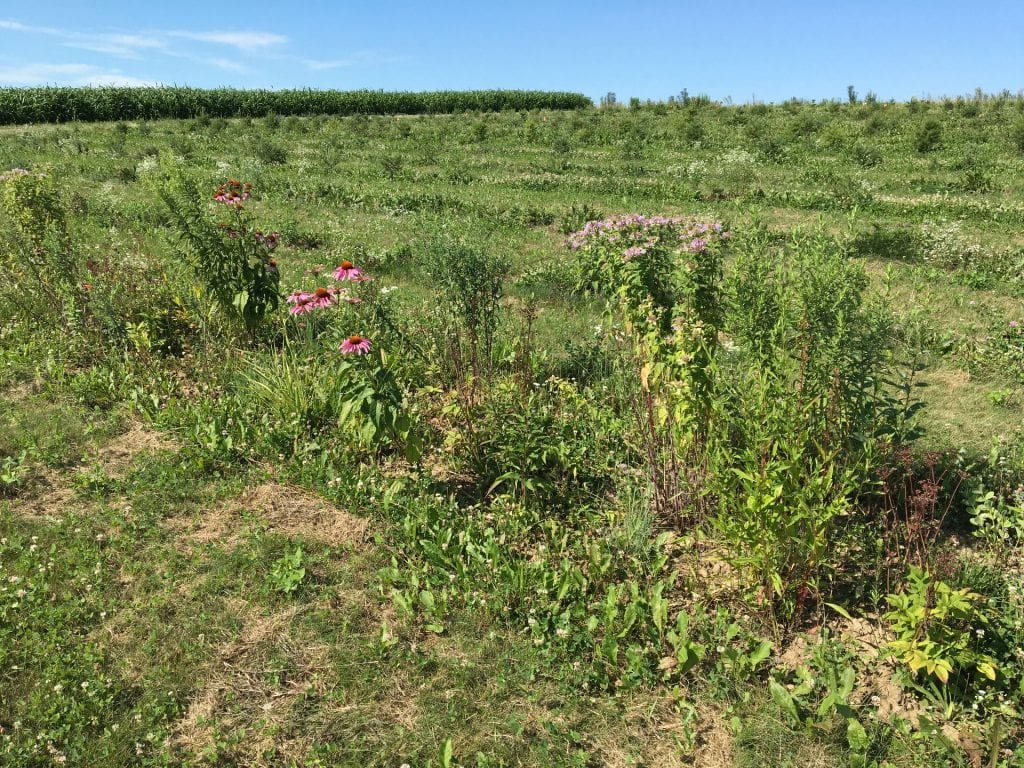
As many people did, we had to change our plans for this project in response to COVID-19. The biggest change was that we didn’t collect any insects this year. If you follow me on Twitter or Instagram, you saw some pictures of different insects I spotted while visiting these plots this summer. Here are a few highlights:
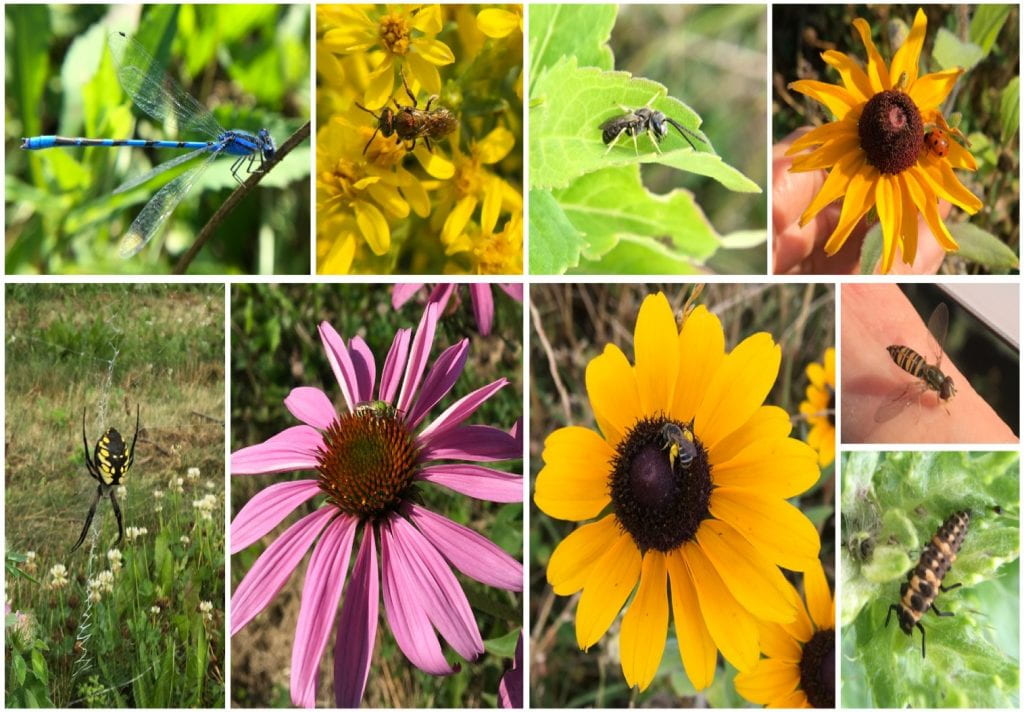
The Christmas trees are still growing, and Brian Eshenaur and I made sure that the weeds didn’t take over. One Christmas tree grower suggested that they might need some trimming next year. I’m adding “Christmas tree shearing” to the list of new things I will try (learn?) in 2021.
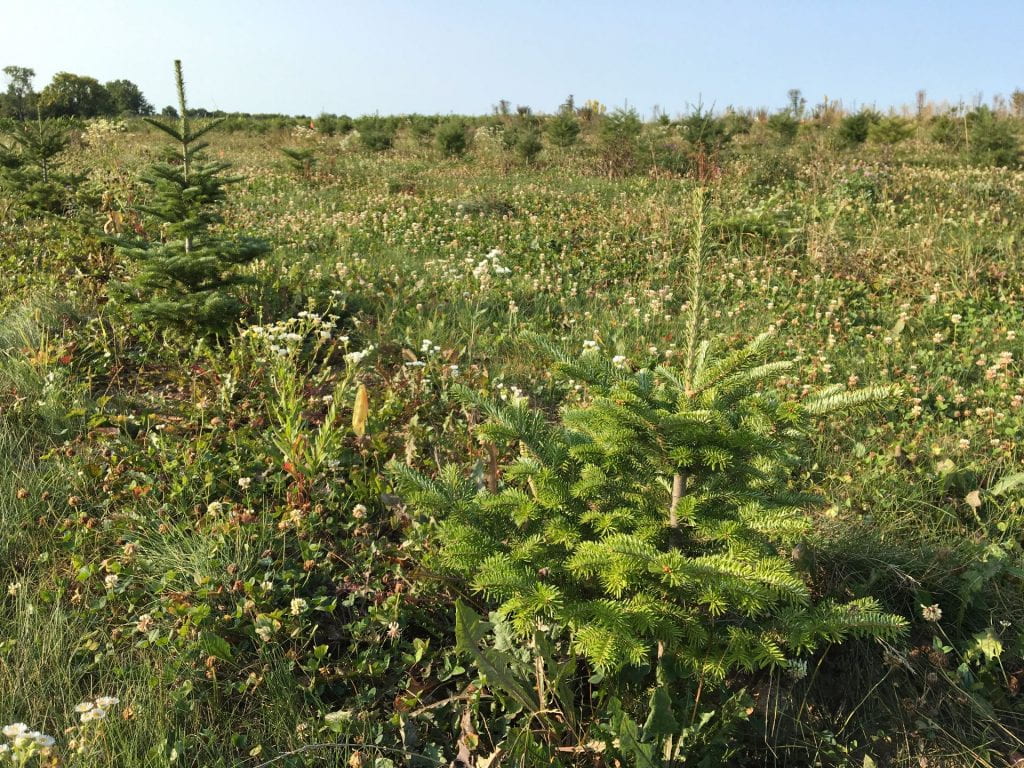
From May through mid-October, I visited our beneficial insect habitat plots once a week to take pictures and document what was blooming. Brian and I also mowed plots that were direct seeded in fall 2018 twice (May and June). Those of you reading this from NY know how dry much of our summer was, and there really wasn’t a need for more frequent mowing. We decided not to mow Treatment C, which had been direct seeded in spring of 2018. The standard recommendation for establishing perennial wildflowers from seed is to mow for the first two growing seasons, and in the third year to start scaling back on the mowing. Since this was the third season for these spring-seeded plots, we skipped the mowing. I’m not sure we made the right decision for our plots.
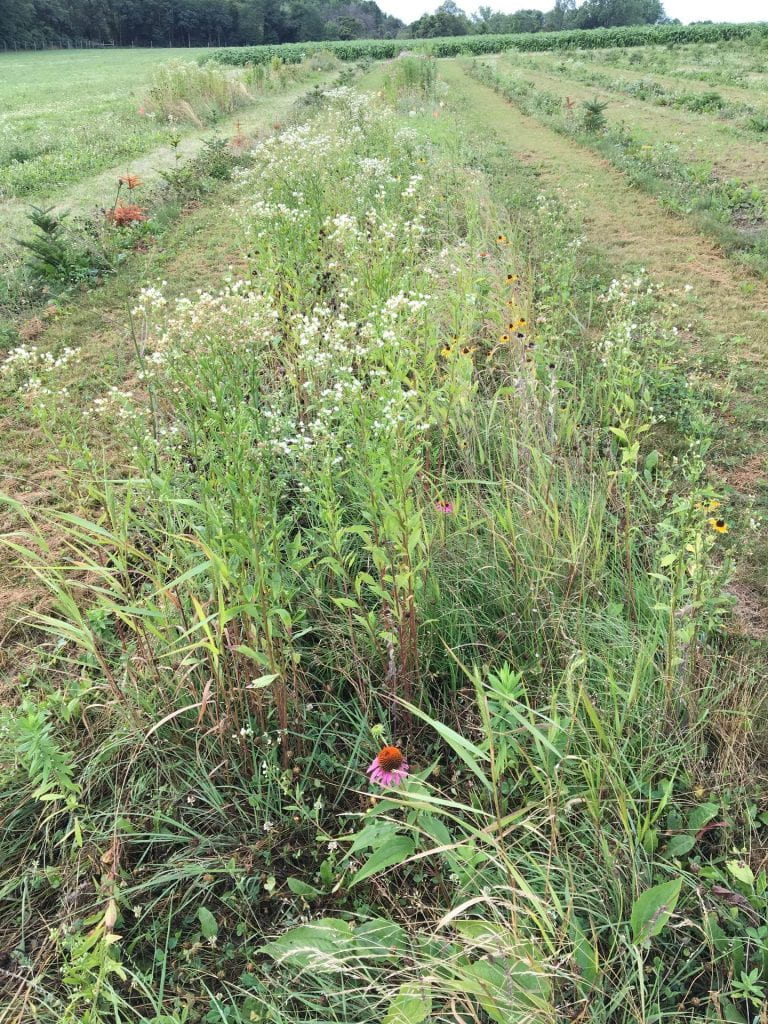
Some of the perennials we seeded bloomed, but mostly these plots were over-run by grass and some weedy asters. It could be that the wildflower establishment was poor. Spring is not the recommended time for planting perennial wildflower seeds. Or it could be that these plots needed to be mowed at least once this season. Since 2021 will be the third year for the fall-seeded plots, I’m wondering about reducing the mowing in these plots, instead of stopping “cold turkey”.
In the meantime, the fall-seeded Treatments F and G (mowed twice in 2020) are developing nicely! Even when there weren’t many flowers, I could recognize lots of wildflower seedlings.
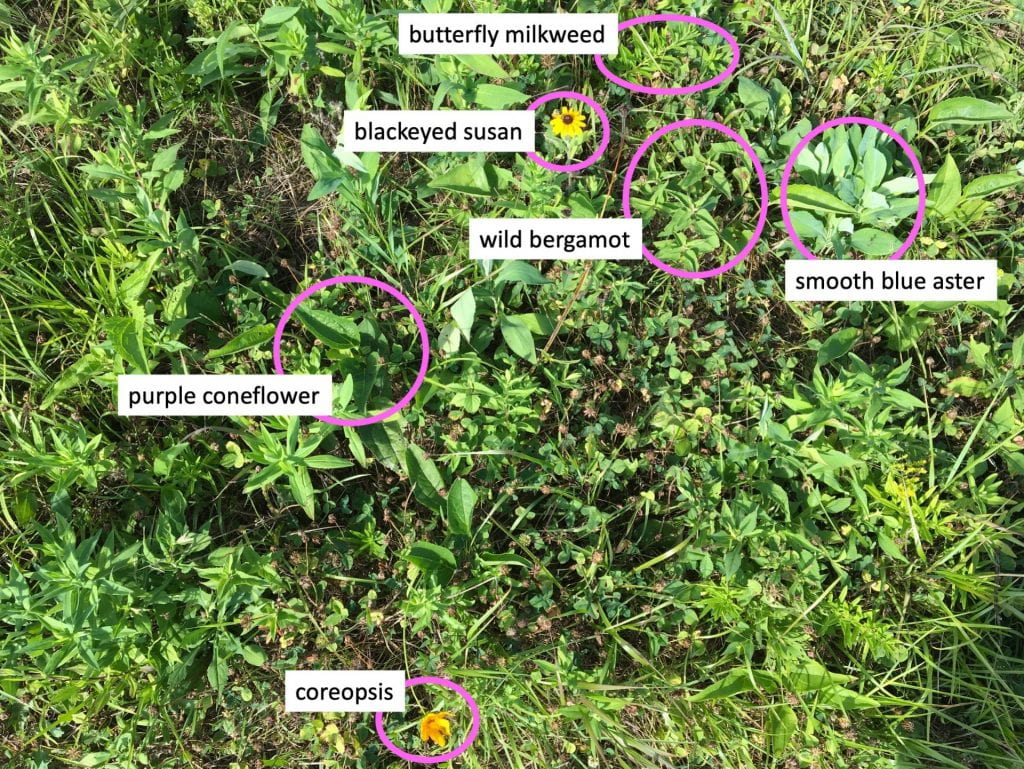
In July and August, there were abundant blackeyed susan blossoms, and in September and October all four aster species bloomed.
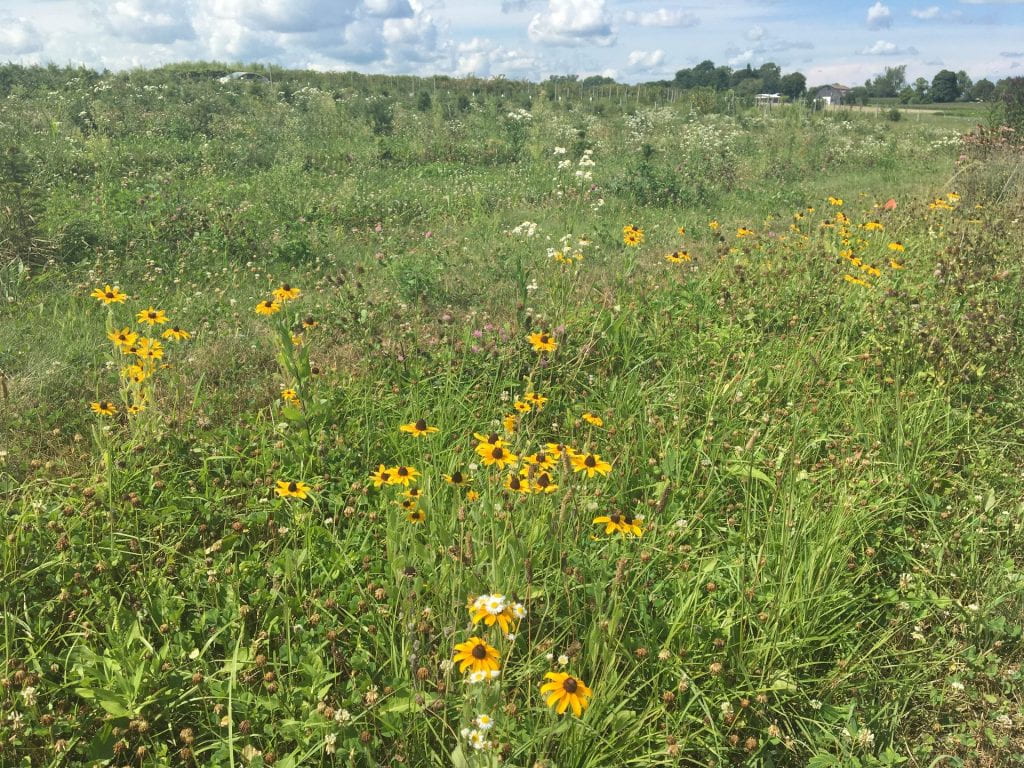
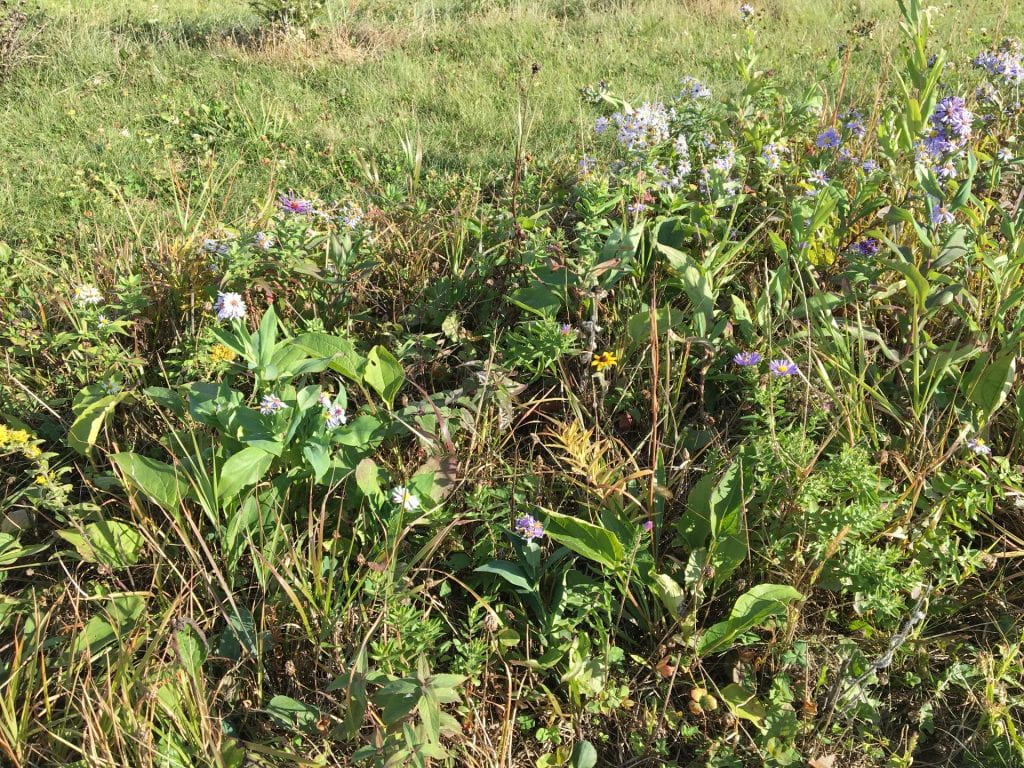
This year, I kept notes not only on what was blooming each week, but on whether blossoms had just started to open (E = early bloom), were fully open (P = peak bloom), or were fading (F = fading bloom). Because there were 12 plots for each transplanted or direct seeded species, if the plots were evenly split between early and peak (E/P) or peak and fading (P/F), I included these two intermediate categories. You can see a color version of the following tables here. The colors give a nice visual of the progression of blooms over the season (including some weeks when there was a bit of a lull in blooms).
| E | early bloom |
| E/P | evenly mixed early & peak bloom in different plots |
| P | peak bloom |
| P/F | evenly mixed peak & fading bloom in different plots |
| F | fading blooms |
When transplanted wildflowers bloomed in 2020
| May | Jun | Jul | Aug | Sep | Oct | |||||||||||||||||||
| 5 | 12 | 21 | 27 | 1 | 9 | 16 | 23 | 30 | 6 | 14 | 21 | 28 | 6 | 12 | 17 | 26 | 1 | 8 | 15 | 22 | 28 | 6 | 14 | |
| Golden alexanders | E | P | P | P | F | F | ||||||||||||||||||
| Ohio spiderwort | E | E | E | P | P | P | F | F | F | F | F | F | F | F | ||||||||||
| Catmint | E | P | P | P/F | F | F | F | F | F | F | F | F | F | F | F | F | F | F | F | F | ||||
| Lanceleaf coreopsis | E | P | F | F | F | |||||||||||||||||||
| Blue false indigo | E | P | ||||||||||||||||||||||
| Tall white beard tongue | E | P | F | F | F | F | ||||||||||||||||||
| Common milkweed | E | F | ||||||||||||||||||||||
| Purple coneflower | E | E | P | P | P | F | F | F | F | F | F | F | ||||||||||||
| Wild bergamot | E | P/F | F | F | F | F | F | |||||||||||||||||
| Anise hyssop | E | P | P | F | F | F | F | F | ||||||||||||||||
| Boneset | E | P | P | F | F | F | F | |||||||||||||||||
| NY ironweed | E | E | E | P | P | P | P | F | F | |||||||||||||||
| Orange coneflower | E | E | P | P | P | P | P/F | F | F | F | F | |||||||||||||
| New England aster | E | E | E | E | P | P | P | F | ||||||||||||||||
| Showy goldenrod | E | P | P | F | F | |||||||||||||||||||
When direct seeded wildflowers bloomed in 2020
| May | Jun | Jul | Aug | Sep | Oct | |||||||||||||||||||
| 5 | 12 | 21 | 27 | 1 | 9 | 16 | 23 | 30 | 6 | 14 | 21 | 28 | 6 | 12 | 17 | 26 | 1 | 8 | 15 | 22 | 28 | 6 | 14 | |
| Golden alexanders | E | P | P/F | |||||||||||||||||||||
| Hairy beard tongue | E | E | ||||||||||||||||||||||
| Lanceleaf coreopsis | E | P/F | F | F | F | F | F | E | P | F | F | F | F | F | F | |||||||||
| Tall white beard tongue | E | |||||||||||||||||||||||
| Blackeyed susan | E | E | P | P | P | P | P | P | P/F | P/F | F | F | F | F | F | F | ||||||||
| Purple coneflower | E | E | P | P | P | P | F | F | F | F | F | F | E/P | |||||||||||
| Wild bergamot | E | F | F | |||||||||||||||||||||
| Butterfly milkweed | P | F | E | |||||||||||||||||||||
| Orange coneflower | E | P | P | P/F | F | F | ||||||||||||||||||
| Smooth blue aster | E | E | P | P | P | P | ||||||||||||||||||
| Gray goldenrod | E | E | E/P | P | F | F | ||||||||||||||||||
| New England aster | E | E | P | P | P | |||||||||||||||||||
| Zigzag aster | E | E | P | P | P | |||||||||||||||||||
| Aromatic aster | E/P | E/P | P | |||||||||||||||||||||
| Yellow false indigo | ||||||||||||||||||||||||
| Partridge pea | ||||||||||||||||||||||||
| Marsh blazing star | ||||||||||||||||||||||||
| Narrowleaf mountainmint | ||||||||||||||||||||||||
| Wild senna | ||||||||||||||||||||||||
| Maryland senna | ||||||||||||||||||||||||
| Early goldenrod | ||||||||||||||||||||||||
| Ohio spiderwort | ||||||||||||||||||||||||
| Common name | Scientific name |
| Anise hyssop | Agastache foeniculum |
| Aromatic aster | Symphyotrichum oblongifolius |
| Blackeyed susan | Rudbeckia hirta |
| Blue false indigo | Baptisia australis |
| Boneset | Eupatorium perfoliatum |
| Butterfly milkweed | Asclepias tuberosa |
| Catmint | Nepeta faassinii |
| Common milkweed | Asclepias syriaca |
| Early goldenrod | Solidago juncea |
| Golden alexanders | Zizia aurea |
| Gray goldenrod | Solidago nemoralis |
| Hairy beard tongue | Penstemon hirsutus |
| Lanceleaf coreopsis | Coreopsis lanceolata |
| Marsh blazing star | Liatris spicata |
| Maryland senna | Senna marilandica |
| Narrowleaf mountainmint | Pycnanthemum tenuifolium |
| New England aster | Symphyotrichum novae-angliae |
| NY ironweed | Vernonia noveboracensis |
| Ohio spiderwort | Tradescantia ohiensis |
| Orange coneflower | Rudbeckia fulgida va. Fulgida |
| Partridge pea | Chamaecrista fasciculata |
| Purple coneflower | Echinacea purpurea |
| Showy goldenrod | Solidago speciosa |
| Smooth blue aster | Symphyotrichum laeve |
| Tall white beard tongue | Penstemon digitalis |
| Wild bergamot | Monarda fistulosa |
| Wild senna | Senna hebecarpa |
| Yellow false indigo | Baptisia tinctoria |
| Zigzag aster | Symphyotrichum prenanthoides |
From the second or third week of May through the second week of October, there was always something blooming in these plots, whether they were transplanted or direct seeded. You can also see that a fair number of species in the seeded plots did not bloom this year. Hopefully next year.
In the meantime, I’ll be making plans for the 2021 growing season, which will hopefully include a return to insect sampling. Stay well and stay safe!
This post was written by Amara Dunn, Biocontrol Specialist with the NYSIPM program. All images are hers, unless otherwise noted.
This work is supported by:
- Crop Protection and Pest Management -Extension Implementation Program Area grant no. 2017-70006-27142/project accession no. 1014000, from the USDA National Institute of Food and Agriculture.
- New York State Department of Agriculture and Markets
- The Towards Sustainability Foundation
